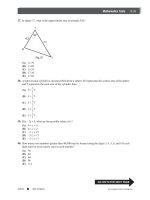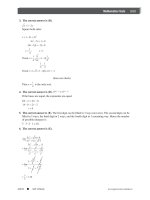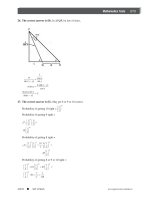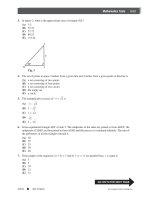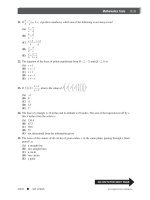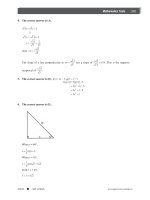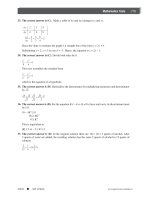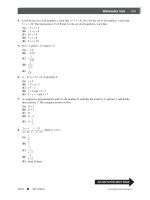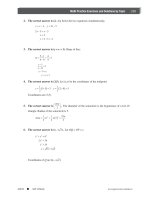SAT II Math Episode 1 Part 4 pdf
Bạn đang xem bản rút gọn của tài liệu. Xem và tải ngay bản đầy đủ của tài liệu tại đây (780.11 KB, 20 trang )
Math Review—Illustrative Problems and Solutions 55
ARCO ■ SAT II Math www.petersons.com/arco
4. Point O is the center of both circles. If the area of shaded region is 9 π and OB = 5, find
the radius of the unshaded region.
Solution:
5. Given rectangle ABCD, semicircles O and P with diameters of 8. If CD = 25, what is the
area of the shaded region?
Solution:
Area of rectangle = 25 ⋅ 8 = 200
Area of both semicircles = π r
2
= 16 π
Area of shaded region = 200 – 16 π
6. Find the ratio of the area of a circle inscribed in a square to the area of the circle circum-
scribed about the square.
Solution:
Let the side of the square be s. Then the radius of
the inscribed circle is
.
Since ∆OTP is right isosceles, the radius OP of the
circumscribed circle is
Area of inner circle =
Area of outer circle =
Part III56
www.petersons.com/arco ARCO ■ SAT II Math
7. A square is inscribed in a circle. What is the ratio of the area of the square to that of the
circle?
Solution:
SOLID FIGURES
1. If the radius of a right circular cylinder is tripled, what must be done to the altitude to
keep the volume the same?
Solution: V = πr
2
h
Tripling r has the effect of mutiplying V by 9. To keep the volume constant, h has to be
divided by 9.
2. The surface area of a sphere is 100 sq in. What is the surface area of a sphere having a
radius twice the radius of the given sphere?
Solution: Since S = 4πr
2
= 100,
3. The ratio of the diagonal of a cube to the diagonal of a face of the cube is
(A)
(B)
(C)
(D)
31:
(E)
63:
Solution: (B) Let each side of cube equal 1.
Math Review—Illustrative Problems and Solutions 57
ARCO ■ SAT II Math www.petersons.com/arco
4. A pyramid is cut by a plane parallel to its base at a distance from the base equal to
two-thirds the length of the altitude. The area of the base is 18. Find the area of the
section determined by the pyramid and the cutting plane.
(A) 1
(B) 2
(C) 3
(D) 6
(E) 9
Solution: (B) Let the area of the section be A.
5. Two spheres of radius 8 and 2 are resting on a plane table top so that they touch each
other. How far apart are their points of contact with the plane table top?
(A) 6
(B) 7
(C) 8
(D)
(E) 9
Solution: (C)
Part III58
www.petersons.com/arco ARCO ■ SAT II Math
6. If the radius of a sphere is doubled, the percent increase in volume is
(A) 100
(B) 200
(C) 400
(D) 700
(E) 800
Solution: (D) Let the original radius = 1.
7. A right circular cylinder is circumscribed about a sphere. If S represents the surface area
of the sphere and T represents the total area of the cylinder, then
(A)
(B)
(C)
(D)
(E)
Solution: (A)
Math Review—Illustrative Problems and Solutions 59
ARCO ■ SAT II Math www.petersons.com/arco
8. A triangle whose sides are 2, 2, and 3 is revolved about its longest side. Find the volume
generated. (Use
)
Solution:
The solid figure formed consists of two congruent
cones. In the figure, Q is the apex of one cone and
the radius r of the base;
Part III60
www.petersons.com/arco ARCO ■ SAT II Math
LOCUS
1. What is the locus of points equidistant from two intersecting lines and at a given distance
d from their point of intersection?
Solution:
The locus of points equidistant from two intersecting
lines consists of the two angle bisectors of the
angles formed by the lines.
At the intersection draw a circle of radius d.
The desired locus is the four points where this circle
intersects the angle bisectors.
2. Two parallel planes are 6 in. apart. Find the locus of points equidistant from the two
planes and 4 in. from a point P in one of them.
Solution: The locus of points equidistant from the two planes is a parallel plane midway between
them (3 in. from each). The locus of points 4 in. from P is a sphere with P as center and
radius 4 in. The intersection of this sphere with the midplane is a circle, the desired locus.
3. Parallel lines r and s are 12 in. apart. Point P lies between r and s at a distance of 5 in.
from r. How many points are equidistant from r and s and also 7 in. from P?
Solution: All points equidistant from r and s lie on a line parallel to r and s and lying midway
between them. All points 7 in. from P lie on a circle of radius 7 and center at P. These two
loci intersect at two points.
4. What is the locus of points in space 4 in. from a given plane and 6 in. from a given point
in the plane?
Solution: The locus of points 4 in. from the given plane consists of two planes parallel to the given
plane. The locus of points 6 in. from the given point is a sphere of radius 6. These two
loci intersect in two circles.
5. What is the equation of the locus of points equidistant from the points (–2, 5) and
(–2, –1)?
Solution: The line segment joining the two points is part of the line x = –2, a vertical line. The
midpoint of the line segment is (–2, 2). The desired locus is the line y = 2.
Math Review—Illustrative Problems and Solutions 61
ARCO ■ SAT II Math www.petersons.com/arco
6. Given ∆PQR. The base
remains fixed and the point P moves so that the area of ∆PQR
remains constant. What is the locus of point P?
Solution:
Since the base remains fixed, the altitude
from P to
must remain constant
to keep the area of ∆PQR
constant. Thus P moves along a
straight line parallel to base
and
passing through P. The mirror of this,
where P is below
, also keeps the
altitude constant. Thus, the locus is a
pair of parallel lines equidistant from
.
II. TRIGONOMETRY
The following trigonometric formulas and relationships are very helpful in solving trigonometric
problems.
Relationships Among the Functions
1. Reciprocal and Quotient Relationships
2. Pythagorean Relationships
sin
2
A + cos
2
A = 1
sec
2
A = 1 + tan
2
A
csc
2
A = 1 + cot
2
A
Part III62
www.petersons.com/arco ARCO ■ SAT II Math
3. The trigonometric function of any angle A is equal to the cofunction of the complementary
angle (90 – A). Thus, sin A = cos(90 – A), etc.
Functions of the Sum of Two Angles
Double Angle Formulas
Half Angle Formulas
Relationships of Sides to Angles in a Triangle
Math Review—Illustrative Problems and Solutions 63
ARCO ■ SAT II Math www.petersons.com/arco
Area Formulas for a Triangle
Graphs of Trigonometric Functions
1. If the equation of a curve is of the form y = b sin nx or y = b cos nx, n > 0, the amplitude of the
curve = b, the period of the curve =
or radians, and the frequency of the curve is the
number of cycles in 360° or 2π radians, which equals n.
2. If the equation of a curve is of the form y = b tan nx or y = b cot nx, n > 0, the period of the curve
=
or radians, and the frequency of the curve is the number of cycles in 180° or π radians,
which equals n.
DEGREE AND RADIAN MEASURE
1. Expressed in radians, an angle of 108° is equal to
(A)
(B)
(C)
(D)
(E)
Solution: (E)
2. The radius of a circle is 9 in. Find the number of radians in a central angle that subtends
an arc of 1 ft in this circle.
Solution:
Part III64
www.petersons.com/arco ARCO ■ SAT II Math
3. The value of cos is
(A)
(B)
(C)
(D)
(E)
Solution: (A)
4. If, in a circle of radius 5, an arc subtends a central angle of 2.4 radians, the length of the
arc is
(A) 24
(B) .48
(C) 3π
(D) 5π
(E) 12
Solution: (E)
5. The bottom of a pendulum describes an arc 3 ft long when the pendulum swings through
an angle of
radian. The length of the pendulum in feet is
(A) 2
(B) 3
(C) 4
(D) 5
(E) 6
Solution: (E)
Math Review—Illustrative Problems and Solutions 65
ARCO ■ SAT II Math www.petersons.com/arco
TRIGONOMETRIC IDENTITIES
1. Express the function sin x in terms of tan x.
Solution: sin x = tan x cos x = tan
Square both sides.
Factor the left member.
Take the square root of both sides.
2. If log tan x = k, express cot x in terms of k.
Solution:
3. Express (1 + sec y)(1 – cos y) as a product of two trigonometric functions of y.
Solution: Multiply the two binomials.
1 + sec y – cos y – sec y cos y
Part III66
www.petersons.com/arco ARCO ■ SAT II Math
4. Write tan 2x numerically, if tan
.
Solution:
5. Simplify and write as a function of x.
Solution:
6. If cos 200° = p, express the value of cot 70° in terms of p.
Solution:
LAW OF SINES
1. If in ∆ABC, A = 30° and B = 120°, find the ratio BC: AC.
Solution: Let BC = a and AC = b.
Math Review—Illustrative Problems and Solutions 67
ARCO ■ SAT II Math www.petersons.com/arco
2. In triangle ABC, A = 30°, C = 105°, a = 8. Find side b.
Solution: If A = 30° and C = 105°, then angle B = 180° – 135° = 45°.
3. If AB and angles x and y are given, express BD in terms of these quantities.
In ∆ABD, by the law of sines,
4. Two sides of a triangle are 5 and 6, and the included angle contains 120°. Find its area.
Solution: Area of triangle
Part III68
www.petersons.com/arco ARCO ■ SAT II Math
LAW OF COSINES
1. If the sides of a triangle are 2, 3, and 4, find the cosine of the largest angle.
Solution: Let x = the angle opposite the side of 4.
Then, by the law of cosines,
2. In ∆ABC, a = 1, b = 1, and C = 120°. Find the value of c.
Solution:
3. In ∆ABC, if a = 8, b = 5, and c = 9, find cos A.
Solution:
GRAPHS OF TRIGONOMETRIC FUNCTIONS
1. How does sin x change as x varies from 90° to 270°?
Solution:
Sketch the graph of y = sin x.
From the graph we see that sin x decreases
continuously from +1 to –1.
Math Review—Illustrative Problems and Solutions 69
ARCO ■ SAT II Math www.petersons.com/arco
2. What is the period of the graph of y = 3 cos 2x?
Solution: The normal period of y = cos x is 2π.
For the graph of y = 3 cos 2x, the period
3. The graph of the function passes through the point whose coordinates are
(A) (0, 2)
(B)
(C)
(D) (π, 1)
(E) (π, 2)
Solution: (E)
Substitute for x the abscissa of each ordered pair in the five choices. Note that when x = π,
The point (π, 2) lies on the graph.
TRIGONOMETRIC EQUATIONS
1. If cos and tan x is positive, find the value of sin x.
Solution:
Since cos x is negative and tan x is positive, x is in the
third quadrant.
In right ∆POQ, the length of
OQ
is 4 and of
O
P
is
5. It follows that PO = – 3.
Therefore, sin
Part III70
www.petersons.com/arco ARCO ■ SAT II Math
2. Find all values of y between 0° and 180° that satisfy the equation 2 sin
2
y + 3 cos y = 0.
Solution: Substitute 1 – cos
2
y for sin
2
y.
3. How many values of x between 0° and 360° satisfy the equation 2 sec
2
x + 5 tan x = 0?
Solution:
For each of the these values of tan x, there are 2 values of x, in Quadrants II and IV. Hence
there are four solutions.
4. The value of x between 180° and 270° that satisfies the equation tan x = cot x is
(A) 200°
(B) 210°
(C) 225°
(D) 240°
(E) 250°
Solution: (C)
In quadrant III, x = 225°.
Math Review—Illustrative Problems and Solutions 71
ARCO ■ SAT II Math www.petersons.com/arco
5. Express, in degrees, the measure of the obtuse angle that satisfies the equation
2 tan θ cos θ – 1 = 0.
Solution: Replace tan θ by
12. GRAPHS AND COORDINATE GEOMETRY
The following formulas and relationships are important in dealing with problems in coordinate geometry.
1. The distance d between two points whose coordinates are (x
1
, y
1
) and (x
2
, y
2
) is
2. The coordinates of the midpoint M(x, y) of the line segment that joins the points (x
1
, y
1
) and
(x
2
, y
2
) are
3. The slope m of a line passing through the points (x
1
, y
1
) and (x
2
, y
2
) is given by
4. Two lines are parallel if and only if their slopes are equal.
5. Two lines are perpendicular if and only if their slopes are negative reciprocals.
6. The equation of a line parallel to the x-axis is y = k where k is a constant.
7. The equation of a line parallel to the y-axis is x = c where c is a constant.
8. The graph of an equation of the form y = mx + b is a straight line whose slope is m and whose
y-intercept is b.
9. The equation of a straight line passing through a given point (x
1
, y
1
) and having slope
m is y – y
1
= m (x – x
1
).
10. The graph of the equation x
2
+ y
2
= r
2
is a circle of radius r with center at the origin.
11. The graph of the general quadratic function y = ax
2
+ bx + c is a parabola with an axis of
symmetry parallel to the y-axis. The equation of the axis of symmetry is
12. The graph of ax
2
+ by
2
= c, where a, b, and c are positive, is an ellipse with center at the origin.
The ellipse is symmetric with respect to the origin.
13. The graph of ax
2
– by
2
= c, where a, b, and c are positive, is a hyperbola symmetric with respect
to the origin and having intercepts only on the x-axis.
Part III72
www.petersons.com/arco ARCO ■ SAT II Math
ILLUSTRATIVE PROBLEMS
1. M is the midpoint of line segment
. The coordinates of point P are (5, –3) and of point
M are (5, 7). Find the coordinates of point Q.
Solution: Let the coordinates of Q be (x, y). Then
Coordinates of Q are (5, 17)
2. A triangle has vertices R(1, 2), S(7, 10), and T(–1, 6). What kind of a triangle is RST?
Solution:
Since the slope of
is the negative reciprocal of the slope of
,
and the
triangle is a right triangle.
3. Find the equation of the straight line through the point (5, –4) and parallel to the line
y = 3x – 2.
Solution: The slope of y = 3x – 2 is 3. The desired line, therefore, has slope 3.
By the point-slope form, the equation is
Math Review—Illustrative Problems and Solutions 73
ARCO ■ SAT II Math www.petersons.com/arco
4. If the equations x
2
+ y
2
= 16 and y = x
2
+ 2 are graphed on the same set of axes, how many
points of intersection are there?
Solution:
Sketch both graphs as indicated.
x
2
+ y
2
is a circle of radius 4 and center at origin.
y = x
2
+ 2 is a parabola. Several points are (0, 2),
(± 1, 3), (± 2, 6).
The graphs intersect in two points.
5. Which of the following points lies inside the circle x
2
+ y
2
= 25?
(A) (3, 4)
(B) (–4, 3)
(C)
(D)
(E) none of these
Solution: (C) The given circle has a radius of 5 and center at the origin. Points A and B are at
distance 5 from the origin and lie on the circle. The distance of D from the origin is
D lies outside the circle.The distance of point C from the origin is
C lies inside the circle.
Part III74
www.petersons.com/arco ARCO ■ SAT II Math
6. For what value of K is the graph of the equation y = 2x
2
– 3x + K tangent to the x-axis?
Solution: If this parabola is tangent to the x-axis, the roots of the equation 2x
2
– 3x + K = 0 are
equal, and the discriminant of this equation must be zero.
7. What is the equation of the graph in the figure?
Solution:
The graph consists of the two straight
lines y = x in the first and third quadrants,
and y = –x in the second and
fourth.
The equation is therefore |y| = |x|
8. What is the equation of the locus of points equidistant from the points (3, 0) and (0, 3)?
Solution:
The locus is the perpendicular bisector
of
P
Q
. This locus is a line bisecting
the first quadrant angle.
Its equation is y = x.
